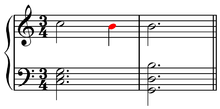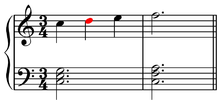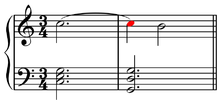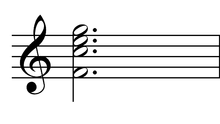- Nonchord tone
-
A nonchord tone, nonharmonic tone, or non-harmony note[citation needed] is a note in a piece of music which is not a part of the implied harmony that is described by the other notes sounding at the time. Nonchord tones are most often discussed in the context of music of the common practice period, but can be used in analysis of other types of tonal music as well.
Chord and nonchord tones are defined by their membership in a chord: "The pitches which make up a chord are called chord-tones: any other pitches are called non-chord-tones."[1] They are also defined by the time at which they sound: "Nonharmonic tones are pitches that sound along with a chord but are not chord pitches."[2]
For example, if a piece of music is currently on a C Major chord, the notes CEG are members of that chord, while any other note played at that time is a nonchord tone. Such tones are most obvious in homophonic music but also often occur in contrapuntal music.
"Most nonharmonic tones are dissonant and create intervals of a second, fourth or seventh",[2] which are required to resolve to a chord tone in conventional ways. If the note fails to resolve until the next change of harmony, it may instead create a seventh chord or extended chord. While it is theoretically possible that for a three-note chord there are (in equal temperament) nine possible nonchord tones, nonchord tones are usually in the prevailing key. Augmented and diminished intervals are also considered dissonant, and all nonharmonic tones are measured from the bass, or lowest note sounding in the chord except in the case of nonharmonic bass tones.[2]
Nonharmonic tones generally occur in a pattern of three pitches, of which the nonharmonic tone is the center:[2] 1 - 2 - 3 Preceding tone - Nonharmonic tone - Following tone (chord tone) - - (chord tone) Preparation - Dissonance - Resolution
Nonchord tones are distinguished through how they are used. The most important distinction is whether they occur on a strong or weak beat and are thus accented or unaccented.[2] They are also distinguished by their direction of approach and departure and the voice or voices in which they occur, and the number of notes they contain.
Over time some nonchord tones supposedly became chord tones, such as the seventh in a seventh chord. In European classical music "The greater use of dissonance from period to period as a result of the dialectic of linear/vertical forces led to gradual normalization of ninth, eleventh, and thirteenth chords[in analysis and theory]; each additional non-chord tone above the foundational triad became frozen into the chordal mass."[3]
The following list is not exhaustive, but identifies the most common types of nonchord tones. The abbreviations found following the names are sometimes used to analyze nonchord tones in scores.
Contents
Unaccented
Anticipation
- An anticipation (ANT) occurs when a note is played before the chord to which the note belongs and resolves when the "anticipated" chord is reached:
Neighbor tone
- A neighbor tone (NT) or auxiliary note (AUX) is a nonchord tone that passes stepwise from a chord tone directly above or below it (which frequently causes the NT to create dissonance with the chord) and resolves to the same chord tone:
In practice and analysis, neighboring tones are sometimes differentiated depending upon whether or not they are lower or higher than the chord tones surrounding them. A neighboring tone that is a step higher than the surrounding chord tones is called an upper neighboring tone or an upper auxiliary note while a neighboring tone that is a step lower than the surrounding chord tones is a lower neighboring tone or lower auxiliary note.
Incomplete Neighbor tone
- An incomplete neighbor tone (IN) is a neighbor tone that has only one stepwise connection with a consonant chord tone (instead of the normal two), the other connection being a skip. Thus, instead of leaving a chord tone with a step up or down and returning to the same chord tone in like manner, one of the chord tones is left out (or skipped over) so the neighbor tone is only connected to one of the chord tones making it incomplete.
- IN's are generally written either:
- With a skip away from a harmony tone to a non-chord tone, and resolved with a step back to a harmony tone (usually in the opposite direction from the approach).
- or
- With a step away from a harmony tone to a non-chord tone, and resolved with a skip back to a harmony tone (also usually in the opposite direction from the approach).
Escape tone
- An escape tone (ET) or echappée is a particular type of unaccented incomplete neighbor tone which is approached stepwise from a chord tone and resolved by a skip in the opposite direction back to the harmony:
Passing tone
- A passing tone (PT) or passing note is a nonchord tone prepared by a chord tone a step above or below it and resolved by continuing in the same direction stepwise to the next chord tone (which is either part of the same chord or of the next chord in the harmonic progression). Where there are two non-chord notes before the resolution we have double passing tones or double passing notes.
Accented
Passing tone
As with above but on an accented beat.
Neighbor tone
As with above but on an accented beat.
Suspension
- A suspension (SUS) occurs when the harmony shifts from one chord to another, but one or more notes of the first chord (the "Preparation") are either temporarily held over into or are played again against the second chord (against which they are nonchord tones called the "Suspension") before resolving to a chord tone stepwise (the "Resolution"). Note that the whole process is called a suspension as well as the specific non-chord tone(s):
Suspensions may be further described using the number of the interval forming the suspension and its resolution; e.g. 4-3 suspension, 7-6 suspension, or 9-8 suspension. Suspensions resolve downwards; otherwise it is a retardation. A suspension must be prepared with the same note (in the same voice) using a chord tone in the preceding chord; otherwise it is an appoggiatura.
Decorated suspensions are common and consist of portamentos or double eighth notes, the second being a lower neighbor tone.
A suspended chord is an added tone chord with a "suspended" fourth or second as an added tone which doesn't resolve.
A chain of suspensions constitutes the fourth species of counterpoint; an example may be found in the second movement of Arcangelo Corelli's "Christmas Concerto".
Retardation
- A retardation (RE) is similar to a suspension except that it resolves upward instead of downward.
Appoggiatura
- An appoggiatura (APP) is a type of accented incomplete neighbor tone approached skip-wise from one chord tone and resolved stepwise to another chord tone.
Portamento
- A portamento is the late Renaissance precursor to the anticipation,[4] though today it refers to a glissando.
Nonharmonic bass
- Nonharmonic bass notes are bass notes which are not a member of the chord below which they are written.
Examples include the Elektra chord.[citation needed]
Involving more than three notes
Nota cambiata
- A nota cambiata is a four note melodic figure and the forerunner of the 18th-century's changing tones. The first and fourth notes are always consonant, while the second and third may or may not be, and the second note is the nota cambiata ("changed note") itself.[5]
Changing tones
- Changing tones (CT) are two successive nonharmonic tones. A chord tone steps to a nonchord tone which skips to another nonchord tone which leads by step to a chord tone, often the same chord tone. They may imply neighboring tones with a missing or implied note in the middle. Also called double neighboring tones or neighbor group.[2]
Pedal point
Another form of nonchord tone is a pedal point or pedal tone (PD) or note, almost always the tonic or dominant, which is held through a series of chord changes. The pedal point is almost always in the lowest voice (the term originates from organ playing), but it may be in an upper voice; then it may be called an inverted pedal. It may also be between the upper and lower voices, in which case it is called an internal pedal.
Chromatic nonharmonic tone
A chromatic nonharmonic tone is a nonharmonic tone that is chromatic, or outside of the key and creates half-step motion. The use of which, especially chromatic appoggiaturas and chromatic passing tones, increased in the Romantic Period.[6]
See also
Sources
- ^ Kroepel, Bob (1993). Mel Bay Creative Keyboard's Deluxe Encyclopedia of Piano Chords: A Complete Study of Chords and How to Use Them, p.8. ISBN 978-0-87166-579-9. Emphasis original.
- ^ a b c d e f Benward & Saker (2003). Music: In Theory and Practice, Vol. I, p.92. Seventh Edition. ISBN 978-0-07-294262-0.
- ^ "Debussy and the Crisis of Tonality", p.72. Author(s): Roland Nadeau. Source: Music Educators Journal, Vol. 66, No. 1, (Sep., 1979), pp. 69-73. Published by: MENC: The National Association for Music Education.
- ^ Benward & Saker (2009). Music in Theory and Practice, Vol. II, p.8. ISBN 978-0-07-310188-0.
- ^ Benward & Saker (2009), p.8.
- ^ a b Benward & Saker (2009), p.217-18.
Consonance and dissonance · Preparation · Resolution · Cadence
Nonchord tone · Pedal point · Cambiata
Categories:- Nonchord tones
- Musical terminology
Wikimedia Foundation. 2010.














